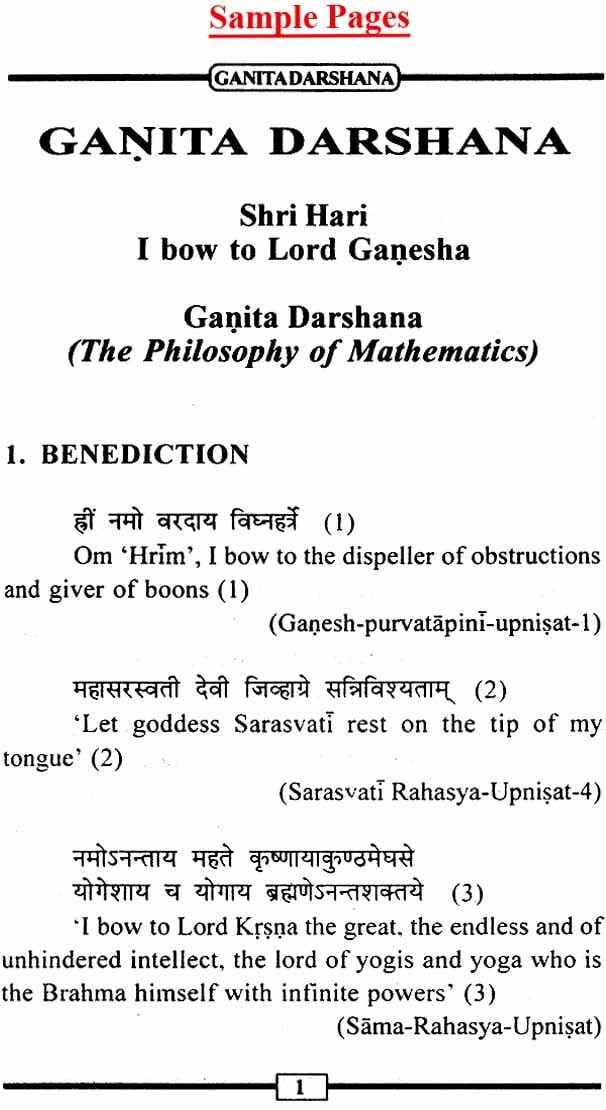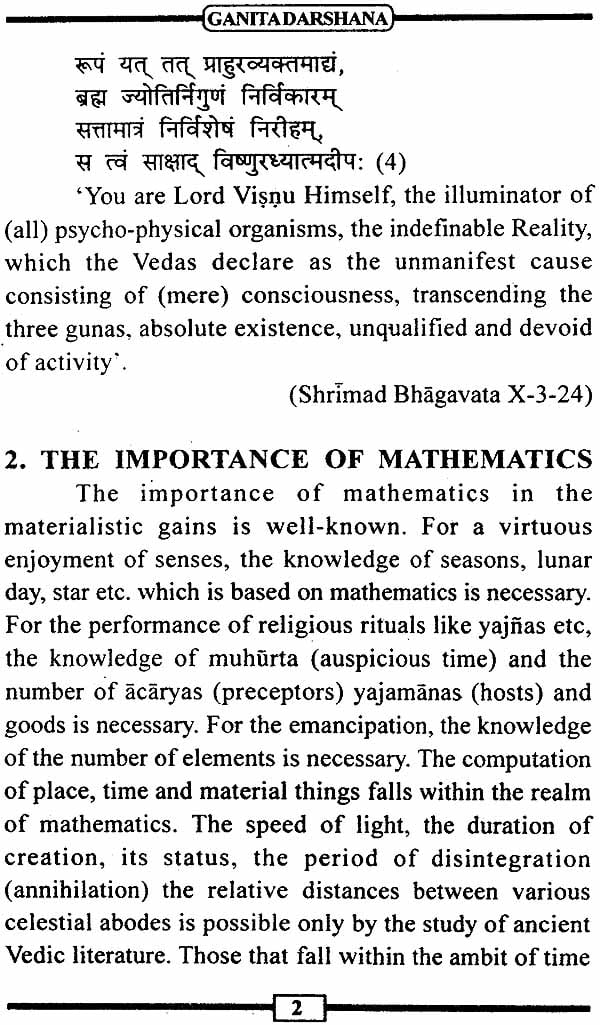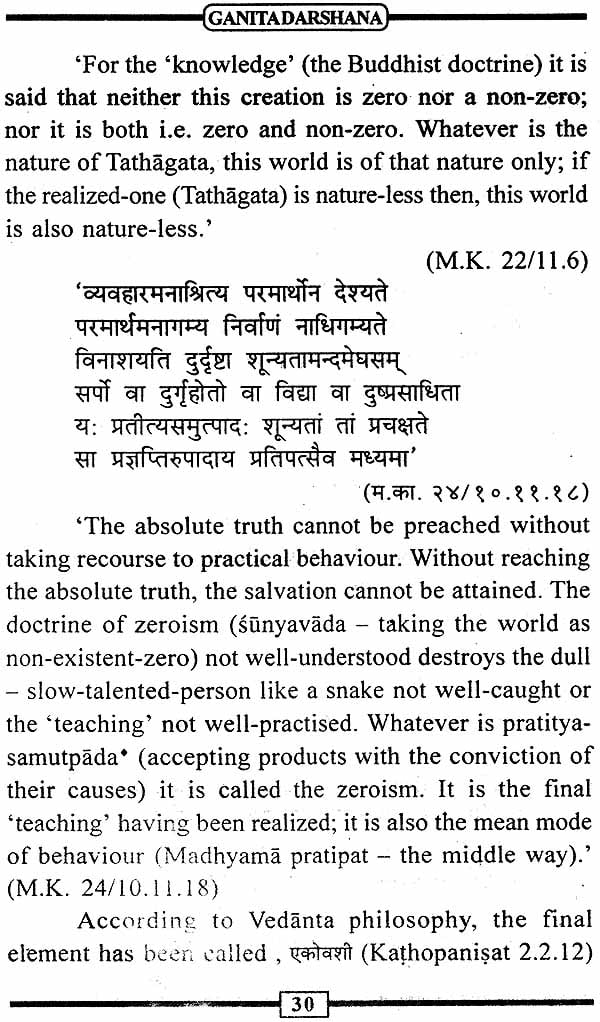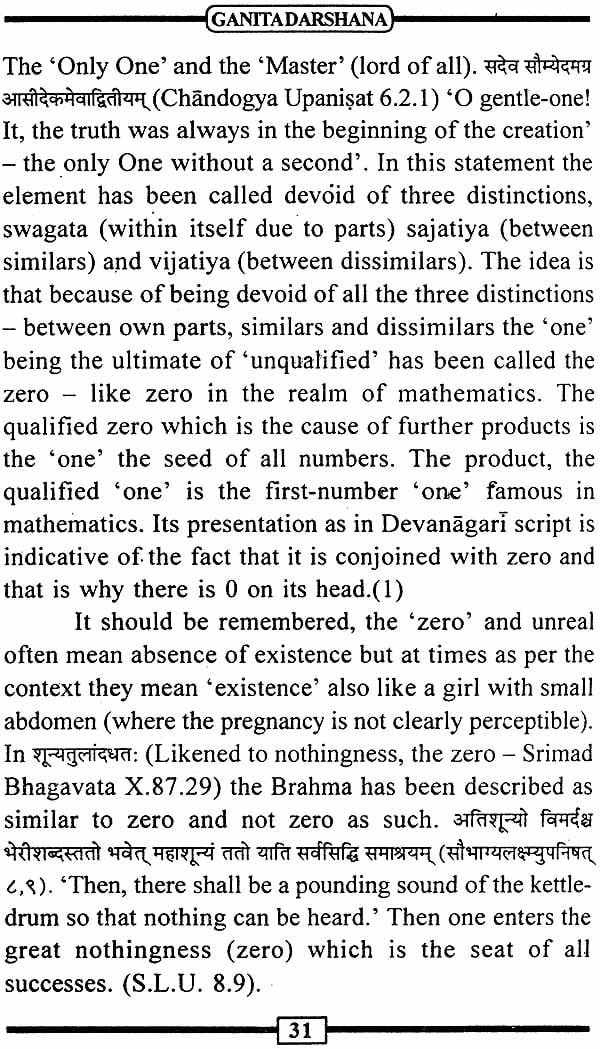
Ganita Darshana - The Philosophy of Mathematics
Book Specification
| Item Code: | NAN155 |
| Author: | Jagadguru Svami Sri Bharati Krsna Tirthaji Maharaja Dr. Mohan Gupta |
| Publisher: | Swasti Prakashan Sansthan, Puri |
| Language: | Sanskrit and English |
| Edition: | 2005 |
| Pages: | 54 |
| Cover: | Paperback |
| Other Details | 8.5 inch x 5.5 inch |
| Weight | 70 gm |
Book Description
Ganita Darshan depicts Mathematics as science of Life fulfilment and liberation. This book also concisely gives an interesting account of Sankhya Darshan, Shoonya Darshana Shoonyavaada as accepted by Buddhist Philosophy and Vedanta Darshana. This book gives an insight into the traditional Vedic understanding of Mathematics. One would benefit in understanding the intricate concepts by personally visiting Sri Govardhan peetham.
The author, His Holiness Jagadguru Shankaracharya Swami Nishchalananda Saraswati Maharaj, the 145th jagadguru Shankaracharya of Govardhan peetham presided over the Holy Seat of Adi shankaracharya in A.D. 1992. His Holiness in internationally reputed for various branches of knowledge viz. Metaphysics, Tantra-Shastra, Yoga, Vedanta, Mathematics, Economics etc. to name a few. His guidance is always sought by institutions like high court in India, UNESCO, World Bank etc.
Due to the unfailing blessings of the Lord and Gurudeva, this is the third creation of his Holiness relating to Mathematics. Earlier, he has authored 'Swastika Ganita' and Ankapadiyarn'.
In this book Ganita Darshana (the philosophy of Mathematics), His Holiness has established mathematics as the source of both 'pleasure' and 'emancipation'. The gradual and continuous increase of numbers from one, two; three etc. upto an infinite number proves the pleasure-orientedness of mathematics, whereas the sequential repetition of them from 0 to 9 proves its emancipator nature. This distinction of mathematics from other physical sciences is of immense importance. The 'sound' in the ether (akasa); the 'sound' and the 'touch' in the air (vayu); the 'sound', the 'touch' and the 'form' in the fire (teja); the 'sound' the 'touch', the 'form' and the 'taste' in the water and the sound; the 'touch', the 'form', the 'taste' and the 'smell' in the earth indicate an additionality of sense-perception (guna) in the primordial five elements. But in earthly creations, this sequential additionality is not visible. Even so, due to other various strange qualities these manifest a unique mutual sequential relationship between powder. a lump. a plate, a pitcher or a seed, a blade, a leave, a flower and the fruit.
In the world of Mathematics, the tradition of sequential increase is never obstructed. But the repetition of 0 to 9 in 10 to 19 or 20 to 29 or even 30 to 39 indicates an obstruction of the qualitative character of an object. This obstruction proves the numbers 0 to 9 as elements. Constant pursuit of elements is a 'cause' in emancipation. Though, like letters in the alphabetical doctrine, the numbers in the numerical doctrine are gross in nature, but like the transcendental speech (paravak) which culminates in Parabrahma (the ultimate existence), the zero, which is the ultimate of non- specificity amounts to non-specific (unqualified) Brahma only.
Because of being the ultimate limit of non-specificity, the Purusa in Sankhya philosophy has been called non-god (anlsvara) or non-element atatva Mahabharata Shanti Parva 305.41) 'Mahabharata, Shanti Parva 305.43). On the principal of the similarity of expression, the unqualified 'one' is called 'zero'in the realm of mathematics. In the realm of mathematics 1,2,3,4,5,6, 7,8 and 9 are respectively nine numerals. The tenth numeral is non-element zero-element. 10 is neither zero, nor one nor a sum or difference of both. It is the composite form of one and zero. Its enumeration in mathematics is after nine at the tenth place in the same way as the Visarga (:) or anusvara (.) are expressed after nine vowels अ इ उ लृ ए ऐ ओ and at the tenth place as an appendices to अ (अ and अ:) If we accept ten (10) as a numeral, we have to accept zero as a numeral because it is related to one. The zero is neither one nor more than one. Hence it is like 'one'. Hence zero is definitely before one. Hence are eleven numbers proved with zero and ten. The zero is like 'purusa' (of sankhya)- The numbers between one to ten are like ten gross and fine basic elements - ether, air, fire, water, earth, sound, touch, form, taste and smell. The expressive 'power' inherent in zero, situated between one and zero and which can be comprehended by indication (anumana) only is like the maya (delusion) or Prakrti (The primordial Nature). The zero consorted with it is one like the qualified over- Lord, the God. From that 'one' which is like the over-Lord is born the one like sky (ether). This fact becomes clear by pondering over the equation 0 + 1 = 1. From the above, it follows that though the number zero has been known as indicative of a nullity, a void, it is not a non-element or power-less (anisvara), Its attributes as non- element or 'anisvara' -are simply negations of its being a doer (karta), an effect (parinama) or even a result (parinami) like the Purusa of Sankhya.
The Sankhya-philosophy gets complete with the uttering of words - Purusa, Prakrti (Primordial Nature) and its product (Prakrta); the Vedanta unfolds fully by saying Brahma, Maya (shakti), Isvara and its manifestation (vivarta). Similarly the philosophy of mathematics completes by saying zero, expressive power (shakti), qualification (savisesa) and expansion (vilasa or vivarta). The zero is like Brahma without any qualification (nirvisesa). The expressive power invested in zero is like Maya. Like the Duo of Brahma and Maya'- the qualified macro-power, the seed of all existence, is 'one'. From this seed, the 'one' enjoined with zero and its expressive power, another' one' like the ether (sky) of Vedanta emerges. The remaining numbers 2 to 10 are like fine and gross elements like' air' fire etc. The numbers from 11 to infinite are their expansion. The zero is the base, locale and material cause of all numbers.
This philosophy of Mathematics has been written with an object of proving the sacred tradition of numbers as a discipline of emancipation like the sacred tradition of letters. In this we find the four functions of mathematics (swastika ganita), the philosophical thoughts contained in another treatise' Ankapadiyam' and some other facts in a compact form. In this we also find the zero and the single digit numbers, the value of zero in double digit or higher numbers and a wonderful method of finding out the value of a number conjoined with zero. Incidentally, the sankhya philosophy, the Shunyavada (the theory of nihilism of Bauddhas) and the substance of vedanta philosophy have also been expounded briefly in an interesting manner.
Contents
| 1 | The Benediction | 01 |
| 2 | The Importance of Mathematics | 02-03 |
| 3 | The Non-element status of Zero | 03-11 |
| 4 | The dependence of zero on numbers | 11-17 |
| 5 | The zero as the root of numbers | 17-37 |
| 6 | The Enjoyment and emancipation by numbers | 38-39 |
| 7 | Conclusion | 40-42 |
| Glossary | 43-48 |









